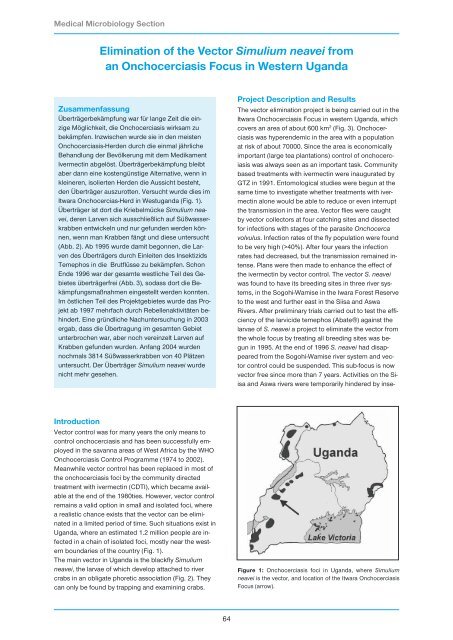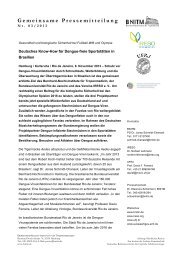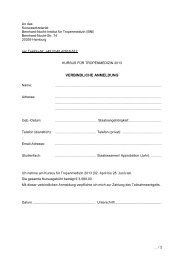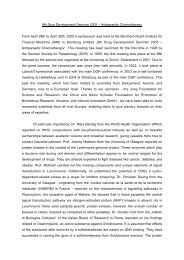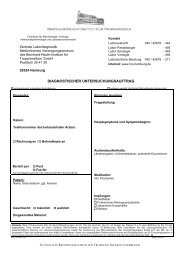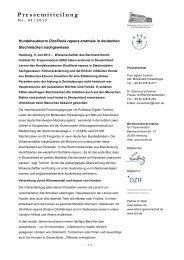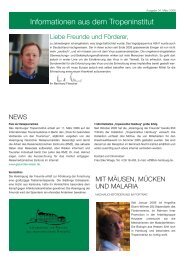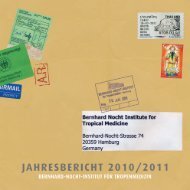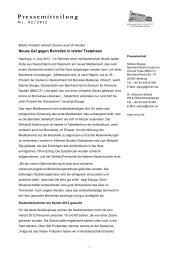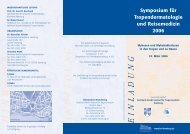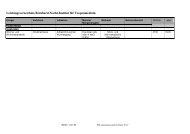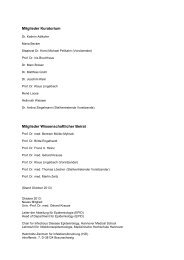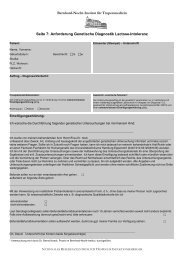Research Group Heussler (Malaria I) - Bernhard-Nocht-Institut für ...
Research Group Heussler (Malaria I) - Bernhard-Nocht-Institut für ...
Research Group Heussler (Malaria I) - Bernhard-Nocht-Institut für ...
Create successful ePaper yourself
Turn your PDF publications into a flip-book with our unique Google optimized e-Paper software.
Medical Microbiology Section<br />
Elimination of the Vector Simulium neavei from<br />
an Onchocerciasis Focus in Western Uganda<br />
Zusammenfassung<br />
Überträgerbekämpfung war <strong>für</strong> lange Zeit die einzige<br />
Möglichkeit, die Onchocerciasis wirksam zu<br />
bekämpfen. Inzwischen wurde sie in den meisten<br />
Onchocerciasis-Herden durch die einmal jährliche<br />
Behandlung der Bevölkerung mit dem Medikament<br />
Ivermectin abgelöst. Überträgerbekämpfung bleibt<br />
aber dann eine kostengünstige Alternative, wenn in<br />
kleineren, isolierten Herden die Aussicht besteht,<br />
den Überträger auszurotten. Versucht wurde dies im<br />
Itwara Onchocercias-Herd in Westuganda (Fig. 1).<br />
Überträger ist dort die Kriebelmücke Simulium neavei,<br />
deren Larven sich ausschließlich auf Süßwasserkrabben<br />
entwickeln und nur gefunden werden können,<br />
wenn man Krabben fängt und diese untersucht<br />
(Abb. 2). Ab 1995 wurde damit begonnen, die Larven<br />
des Überträgers durch Einleiten des Insektizids<br />
Temephos in die Brutflüsse zu bekämpfen. Schon<br />
Ende 1996 war der gesamte westliche Teil des Gebietes<br />
überträgerfrei (Abb. 3), sodass dort die Bekämpfungsmaßnahmen<br />
eingestellt werden konnten.<br />
Im östlichen Teil des Projektgebietes wurde das Projekt<br />
ab 1997 mehrfach durch Rebellenaktivitäten behindert.<br />
Eine gründliche Nachuntersuchung in 2003<br />
ergab, dass die Übertragung im gesamten Gebiet<br />
unterbrochen war, aber noch vereinzelt Larven auf<br />
Krabben gefunden wurden. Anfang 2004 wurden<br />
nochmals 3814 Süßwasserkrabben von 40 Plätzen<br />
untersucht. Der Überträger Simulium neavei wurde<br />
nicht mehr gesehen.<br />
Introduction<br />
Vector control was for many years the only means to<br />
control onchocerciasis and has been successfully employed<br />
in the savanna areas of West Africa by the WHO<br />
Onchocerciasis Control Programme (1974 to 2002).<br />
Meanwhile vector control has been replaced in most of<br />
the onchocerciasis foci by the community directed<br />
treatment with ivermectin (CDTI), which became available<br />
at the end of the 1980ties. However, vector control<br />
remains a valid option in small and isolated foci, where<br />
a realistic chance exists that the vector can be eliminated<br />
in a limited period of time. Such situations exist in<br />
Uganda, where an estimated 1.2 million people are infected<br />
in a chain of isolated foci, mostly near the western<br />
boundaries of the country (Fig. 1).<br />
The main vector in Uganda is the blackfly Simulium<br />
neavei, the larvae of which develop attached to river<br />
crabs in an obligate phoretic association (Fig. 2). They<br />
can only be found by trapping and examining crabs.<br />
64<br />
Project Description and Results<br />
The vector elimination project is being carried out in the<br />
Itwara Onchocerciasis Focus in western Uganda, which<br />
covers an area of about 600 km 2 (Fig. 3). Onchocerciasis<br />
was hyperendemic in the area with a population<br />
at risk of about 70000. Since the area is economically<br />
important (large tea plantations) control of onchocerciasis<br />
was always seen as an important task. Community<br />
based treatments with ivermectin were inaugurated by<br />
GTZ in 1991. Entomological studies were begun at the<br />
same time to investigate whether treatments with ivermectin<br />
alone would be able to reduce or even interrupt<br />
the transmission in the area. Vector flies were caught<br />
by vector collectors at four catching sites and dissected<br />
for infections with stages of the parasite Onchocerca<br />
volvulus. Infection rates of the fly population were found<br />
to be very high (>40%). After four years the infection<br />
rates had decreased, but the transmission remained intense.<br />
Plans were then made to enhance the effect of<br />
the ivermectin by vector control. The vector S. neavei<br />
was found to have its breeding sites in three river systems,<br />
in the Sogohi-Wamise in the Iwara Forest Reserve<br />
to the west and further east in the Siisa and Aswa<br />
Rivers. After preliminary trials carried out to test the efficiency<br />
of the larvicide temephos (Abate®) against the<br />
larvae of S. neavei a project to eliminate the vector from<br />
the whole focus by treating all breeding sites was begun<br />
in 1995. At the end of 1996 S. neavei had disappeared<br />
from the Sogohi-Wamise river system and vector<br />
control could be suspended. This sub-focus is now<br />
vector free since more than 7 years. Activities on the Siisa<br />
and Aswa rivers were temporarily hindered by inse-<br />
Figure 1: Onchocerciasis foci in Uganda, where Simulium<br />
neavei is the vector, and location of the Itwara Onchocerciasis<br />
Focus (arrow).


